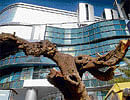Cool City warms up to mercury

Things are hotting up in the City. Several parts of Bangalore are witnessing an increase in the land surface temperature (LST) by as much as two degrees Celcius over the past few years, a study by the Indian Institute of Science (IISc) has claimed.
According to the research study, headed by IISc’s Energy and Wetland Research Centre (EWRC) senior scientist Dr T V Ramachandra, Bangalore, otherwise known as the ‘Garden City’, is losing its vegetation cover and water bodies because of the heat islands in different parts. A research paper, with the study’s findings, were published in the International Journal of Geo Informatics in September 2009.
The study team found evidence that unplanned urbanisation was the principal reason for the heat islands within and outside the City limits. The EWRC, which studied the changing climatic patterns in the City between 1992 and 2007, found Bangalore experienced a rise in the built-up area by 466 per cent between 1973 and 2007. This, according to the study, caused nearly 66 per cent loss to vegetation.
“Continuing our study from 2007, we found that the temperature is high in three growth poles of ITPL which includes Whitefield, Hosur Road and surrounding places where there has been a lot of developmental activities. The other two places are Peenya Industrial zone in North Bangalore and residential complexes of Bangalore South,” explained Dr Ramchandra.
He said these places were turning into heat islands where temperature rise was alarming. “Heat islands lead to increased use of energy for home appliances like airconditioners and coolers and other equipment that further add to the increase in temperature. At this rate, the City will end up as a major contributor of carbon,” he pointed out.
Explaining the methodology adopted for the study, Dr Ramachandra said the team of researchers were divided into eight groups who undertook field studies in as many locations of the city, using remote sensing and GPS tools to analyse the temperature pattern change.
“We analysed that temperature at some of these pockets was higher by about 3-4 degrees. But the places with sufficient vegetation and water bodies experienced relatively low temperature,” he said.
It was found that places like Indian Institute of Science (IISc) campus, Lalbagh, Cubbon Park, Hebbal lake, Ramasandra, Ullal lake, Bangalore University and other places with vegetation or water bodies were much cooler. “The vegetation cover and water bodies act as heat syncs,” said Dr Ramachandra.
In his opinion, there was a corelation between the shift in the temperature patterns and the Information Technology and biotechnology boom that began in the Nineties. The IISc study appears to be supported by the independent findings of the Met department that maintains a daily record of temperature over a much a longer period of time.
“There has been an increase in the minimum temperature during winters. At the same time, the natural temperature has been increasing during the summer months,” said Meterological Department director Muthuchami.
Deccan Herald is on WhatsApp Channels| Join now for Breaking News & Editor's Picks